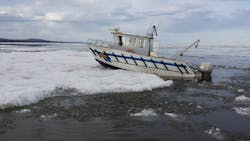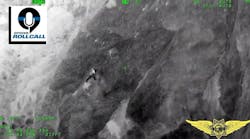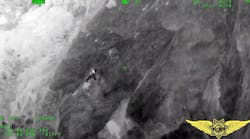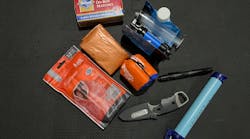For most of us water is water. If you can stand up in it, it presents little threat unless it’s moving fast enough to sweep you off your feet. If the water is deeper than you are tall at the shoulder, then all water presents a readily recognized drowning threat. Recovering evidence, however, can be difficult in even a foot of brackish water and the challenges surrounding the recovery of anything—evidence, bodies or other items—in deep water can be quite daunting.
Common recreational scuba diving is limited to depths less than 120 feet. Functioning in that depth or less requires specialized training in the use of the equipment and the physiological concerns accompanying the varying pressures. Being able to search for—with any reasonable hope of finding—specific items requires a higher level of training and includes methodology that builds on typical land-based search tactics. Lighting, communication, recovery, preservation, all are unique due to the underwater environment and create challenges that multiply with each additional issue. Further, ANY scuba diving comes with a certain level of risk and diving any deeper than the aforementioned 120-foot increases the risk a great deal. The chance of injury or death to the diver has to be measured against the value of the item being recovered for any law enforcement agency. The default position, as all law enforcement administrators know, is no piece of evidence is worth the life of an officer.
It’s obvious that searching for and recovering items under water of any depth can present unique challenges. If you make the depths of the water deeper, the challenges begin to grow at astronomical rates. Not being able to physically attain those depths without highly specialized equipment (and increased health risks) means we have to depend on various types of technology. There is certainly technology available that allows us to search at depth, and (usually) separate equipment that allows us to perform recovery operations at depth.
If an agency has responsibility for deep water areas, they have to budget not only for the equipment but also for the training to use and maintain such equipment. While funding from grants is always an option, we all know there is no guarantee of receipt no matter how well you articulate your need for or use of the funds. One agency that has had some success is the St. Louis, Minnesota Sheriff’s Office.
We spoke with Undersheriff David Phillips of that office which encompasses 640 lakes, part of Lake Superior and the Boundary Waters Canoe Area. In other words, there is a LOT of deep water in his jurisdiction. Undersheriff Phillips was very forthcoming with information regarding the value and use of various types of underwater search and recovery technology, but before he would even discuss such with us he had one strong admonition to make: “Sonar, whether it’s multi-beam, side-scan, what have you…it takes training, skill, maintenance and regular use if you’re going to become and remain proficient. It’s a perishable skill, just like marksmanship. You can’t buy the gear and think you’re ready to go. There is a big training requirement, a learning curve, constant updates and the need to keep your skills polished. If you fail to do so, at best the equipment goes unused and rusts away into junk. At worst you use the equipment in the wrong way and fail to accomplish whatever your mission is. If that happens, you’ve just wasted money on equipment and gained nothing but wasted time.”
With that warning acknowledged, we discussed the benefits of today’s sonar technology, which Undersheriff Phillips says might have been classified by the military as little as 15 years ago. The option, however, to such search technology, is having divers do the work. Undersheriff Phillips mentioned that he was a certified scuba diver and he mentioned the potential liability of having a diver even go into shallow water for evidence recovery. In today’s recreational dive world, there are divers reaching depths of 300+ feet but for an agency to send a diver that deep when equipment is readily available to take the risk away is unprofessional in his opinion. So the minimization or removal of diver liability is the first and strongest benefit of using sonar technology for searches.
The next greatest benefit, according to Phillips, is the combination of depth and clarity that can be achieved with some sonar technology today. A good sonar unit shows everything within a 130° arc in front of the unit carrying it. That could be a remotely operated underwater vehicle (ROV), a small sub or an underwater robotics platform (URP). Additionally, the sonar can identify distance to objects and, given geometric relationships, can actually map out the size and dimensions of an object underwater.
Undersheriff Phillips made a point of mentioning the difference between what the human eye can see and what sonar can see. It’s important given how bad visibility can be underwater. Even if the water hasn’t been moved, the bottom of any body of water is usually covered with silt or mud or some combination thereof. A body could be under as little as an inch or so of silt/mud and not be recognizable even if an ROV with a video camera was looking right at it. If you stir the water up around it and the silt gets churned, visibility can be reduced to near nothing and you wouldn’t even be able to see the floor of the body of water.
Phillips mentioned that there have been two big developments in sonar and side-scan sonar in recent years. The first is that the power demands have been reduced. When you’re trying to make a unit as portable as possible, power demand can a huge issue. Contemporary submersibles have a lower power requirement and Phillips mentioned one that can be run using a 2000W Honda generator. With such a setup, Phillips recalled an experience where he ran a smaller ROV called a VideoRay Pro4 out of an ice tent. (He had to clarify what an ice tent is since we didn’t know due to differing locations and climates.)
The second big development that Phillips mentioned was the evolution of control software and programming. In the early days of sonar and side scan sonar being mounted on ROVs or URPs, the controller had to understand and be familiar with how to control both the platform and the sonar equipment. As technologies have evolved, controlling either one has gotten easier and controlling both is getting to the point where, as Phillips puts it, “staff will be able to use it at 0200 in the pouring rain.” In other words, it’s easy to use under adverse conditions.
A hefty price tag
Undersheriff Phillips says that St. Louis County, Minnesota, has roughly $750K worth of underwater robotics and sonar equipment (so far). He indicated that the equipment had been acquired largely through the use of grant funding and is used by far more agencies than just the county. Phillips states that he has worked all around the country and even has done some international work. It makes sense. There are only so many locations with civilian law enforcement personnel trained to operate such equipment AND who have access to it. Outside of such skilled personnel, you’d be looking at a mostly military application of the equipment.
If your agency is responsible for, or has jurisdiction over, any body or bodies of water that reach depths in excess of 50 feet, it might be worth your time (and liability management funding) to investigate the potential of underwater robotics equipment and sonar gear. There will always be a need to search underwater for evidence, bodies and other items. Doing so with scuba divers both limits the depths to which you can function and increases your agency’s potential liability attached to every search. Using underwater robotics and good sonar equipment, you can accomplish the same mission more efficiently and with reduced risk.
“Technologies may never truly replace dive teams,” says Undersheriff Phillips. “But for many organizations tasked with drowning recoveries and underwater searches, they may find that you can have virtually unlimited bottom time and good bottom coverage with no risk to staff when using good quality side scan, robotics platforms, and multibeam sonar technologies. That said, these programs must be supported from the top down to encourage regular use and training.”



